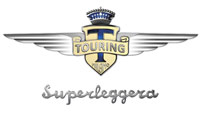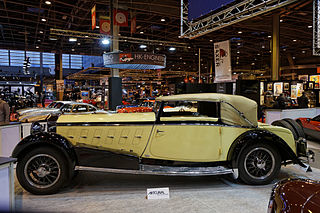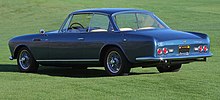History
The history of the business goes back to 1924 which was when Hermann Graber, then aged 21, took over his father's wheel making business and quickly reconfigured it for the production of car bodies.
The company's first car, a two-seater cabriolet bodied Fiat 509 was presented in 1927. Two years later a Graber bodied Panhard & Levassor 20 CV won the Concours d'Elegance at St. Moritz as a result of which the "Carrosserie Graber" business became known across Europe. During the 1930s the company built a number of special bodies on a range of chassis from Alfa Romeo, Bentley, Bugatti, Duesenberg and Packard.
In the early 1930s France had lost to Britain its position as Europe's largest automobile producer, and Britain would retain the top slot until the early 1950s so it made sense for Graber, after the war, to concentrate on special car bodies designed to complement some of the more exclusive chassis produced by the UK auto-industry, which they did, especially in respect of Alvis and Bentley, Aston Martin, Lagonda, Rolls-Royce and Rover as makers of cars with separate chassis
In 1946 Graber made his first Alvis body and by 1953 acquired the Swiss distribution rights for Alvis Cars. In 1955, in response to a customer order from Alvis, they produced what would turn out to be the first two of several Graber bodied prototypes on an Alvis chassis. [1]
During the 1950s links between Graber and Alvis became close. After the long-time Alvis designer G.T. Smith-Clarke left the company, Graber presented in 1955 his Graber bodied Alvis TC 21/100 "Grey Lady" which somehow combined classical elegance with a thoroughly modern pontoon format body. [2] The new Alvis bodies went into series production, under licence by the British firms firstly with Willowbrook and later Park Ward. [3] Park Ward took the Swiss drawings and adapted them to produce a car with more interior space than the Graber original. All the subsequent Alvis TD TE and the very last TF21 followed Graber's basic blueprint. Meanwhile, in central Switzerland Graber continued to build to order special bodied cars based on Alvis chassis at a rate of not more than ten per year. These included four seater coupe bodied cars (sometimes described by the English as saloons), cabriolets, and four four-door specials. Graber's bodies were lower than the standard bodied Alvis cars with more steeply raked A and C pillars. When customers requested improvements, Graber was happy not merely to produce special bodies but also to redesign or adapt aspects of the chassis and running gear. [4]
Hermann Graber died in 1970 and the production of special bodied cars at Wichtrach came to an end. About 800 Graber bodied vehicles had by now been produced. The business continued to operate under the control of his widow, specialising now in the repair and maintenance of car bodies. Between 1980 and 1996 the Graber business held a franchise as an official Ferrari importer. In 2001 the residuum of the business was acquired by a well-known Swiss classic car restorer named Markus Scharnhorst, and relocated to Toffen. [5]

Giovanni Michelotti was one of the most prolific designers of sports cars in the 20th century. His notable contributions were for Ferrari, Lancia, Maserati and Triumph marques. He was also associated with truck designs for Leyland Motors, and with designs for British Leyland after the merger of Leyland and BMC.

Gruppo Bertone, commonly known as Bertone, was an Italian industrial design company which specialized in car styling, coachbuilding and manufacturing. It was also a car manufacturing company. Bertone styled cars for Abarth, Alfa Romeo, Aston Martin, BMW, Citroën, Ferrari, Fiat, Iso, Lancia, Lamborghini, Mercedes-Benz, Opel, and Volvo, among others. In addition, the Bertone studio was responsible for two of the later designs of the Lambretta motorscooter.

Vanden Plas is the name of coachbuilders who produced bodies for specialist and up-market automobile manufacturers. Latterly the name became a top-end luxury model designation for cars from subsidiaries of British Leyland and the Rover Group, being last used in 2009 to denote the top-luxury version of the Jaguar XJ (X350).
Vignale is the luxury car sub-brand of Ford Motor Company used in automobiles sold in Europe. The former company Carrozzeria Alfredo Vignale was an Italian automobile coachbuilder established in 1948 at Via Cigliano, Turin, by Alfredo Vignale (1913–69). After its founder's death in 1969, Carrozzeria Vignale was acquired by De Tomaso. The studio ceased operation in 1973, but ownership of the name was taken over by Ford Motor Company.

Alvis Car and Engineering Company Ltd was a British manufacturing company in Coventry from 1919 to 1967. In addition to automobiles designed for the civilian market, the company also produced racing cars, aircraft engines, armoured cars and other armoured fighting vehicles.

Carrozzeria Touring Superleggera is an Italian automobile coachbuilder. Originally established in Milan in 1925, Carrozzeria Touring became well known for both the beauty of its designs and patented superleggera construction methods. The business folded in 1966. In 2006 its brands and trademarks were purchased and a new firm was established nearby to provide automotive design, engineering, coachbuilding, homologation services, non-automotive industrial design, and restoration of historic vehicles.

A coachbuilder or body-maker is a person or company who manufactures bodies for passenger-carrying vehicles. Coachwork is the body of an automobile, bus, horse-drawn carriage, or railway carriage. The word "coach" was derived from the Hungarian town of Kocs. A vehicle body constructed by a coachbuilder may be called a "coachbuilt body" or "custom body".

The Alfa Romeo 1900 is an automobile produced by Italian car manufacturer Alfa Romeo from 1950 until 1959. Designed by Orazio Satta, it was an important development for Alfa Romeo as the marque's first car built entirely on a production line and first production car without a separate chassis. It was also the first Alfa Romeo offered with left-hand drive. The car was introduced at the 1950 Paris Motor Show.

Abbey Coachworks Limited was a British coachbuilding business based in Merton, South West London and later Acton, North West London. It was active between 1930 and 1938.

The Alvis Three Litre Series III sports saloon or drophead coupé, also known as TE 21, is an automobile produced by English manufacturer Alvis between 1963 and 1966 with a body built by Mulliner Park Ward. It was an updated version of the 1958 TD21.

Carrozzeria Castagna is an Italian coachbuilding company based in Milan, Italy.

Carrosserie Pourtout was a French coachbuilding company. Founded by Marcel Pourtout in 1925, the firm is best known for its work in the decades prior to World War II, when it created distinctive and prestigious bodies for cars from numerous European manufacturers. Pre-war Pourtout bodies were mainly one-off, bespoke creations, typically aerodynamic and sporting in character. Together with chief coach designer and stylist Georges Paulin from 1933 to 1938, Pourtout pioneered the Paulin invented 'Eclipse' retractable hardtop system on four models of Peugeot, several Lancia Belna's and other car makes.
Among the company's customers was Georges Clemenceau, the physician and journalist who served as the prime minister of France from 1906 to 1909 and 1917 to 1920.

The DKW F8 is a compact front-wheel drive two-stroke engined saloon, introduced in 1939. The F8 was slightly shorter than its predecessor despite having a marginally increased wheelbase. The base model, known as the Reichsklasse, was manufactured only till 1940 but the Meisterklasse sedan continued in production until 1942. In addition to the saloons, cabriolet versions were offered.

The Mercedes-Benz 500K (W29) is a grand touring car built by Mercedes-Benz between 1934 and 1936. First exhibited at the 1934 Berlin Motor Show, it carried the factory designation W29. Distinguished from the 500 sedan by the "K" for Kompressor, only fitted to these performance cars, it succeeded the Mercedes-Benz 380 introduced just the previous year. It offered both a larger, more powerful engine and more opulent coachwork to meet customers' demands for greater luxury and performance.

Saoutchik was a French coachbuilding company founded in 1906 and based in Neuilly-sur-Seine near Paris. The company was one of the best-known coachbuilders in France in the 1920s and 1930s and, together with Figoni et Falaschi and Franay, is considered one of the most important representatives of the "Baroque" style in French coachwork in the 1930s and 1940s.
Figoni et Falaschi is a French luxury brand and coachbuilder firm which was active from 1935 through to the 1950s. The designs were created by Giuseppe Figoni, while his partner Ovidio Falaschi ran the business.

Carrosserie Vanvooren was a French Coachbuilder based in the north-western Paris suburb of Courbevoie. The company concentrated on producing car bodies for luxury cars, being closely associated, during the 1930s, with the products of Hispano-Suiza, Bugatti, Rolls-Royce and Bentley.
Franay was a French coachbuilder operating at Levallois-Perret, a suburb on the prosperous north-western edge of Paris. The company was founded in 1903 by Jean-Baptiste Franay, a carriage upholsterer, following an apprenticeship with Binder. It was later taken over by his son, Marius. Franay car body production stopped in late 1955.

Carrosserie Worblaufen, F. Ramseier & Co. was a Swiss manufacturer of car bodies headquartered in Worblaufen near Bern from 1929 to 1958. The company is different to Carrosserie Ramseier in Bern and Biel.
Carrosserie + Spritzwerk Beutler AG, previously Gebr. Beutler & Cie. and Carrosserie Beutler AG was a Swiss coachbuilder that manufactured handcrafted bodies on passenger car chassis.




















